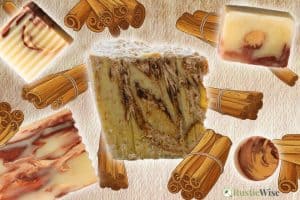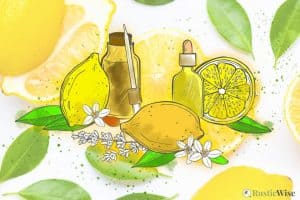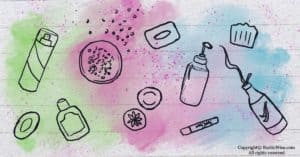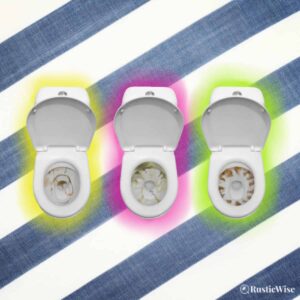7 Aloe Vera Soap Benefits + Easy DIY Liquid Aloe Soap Recipe
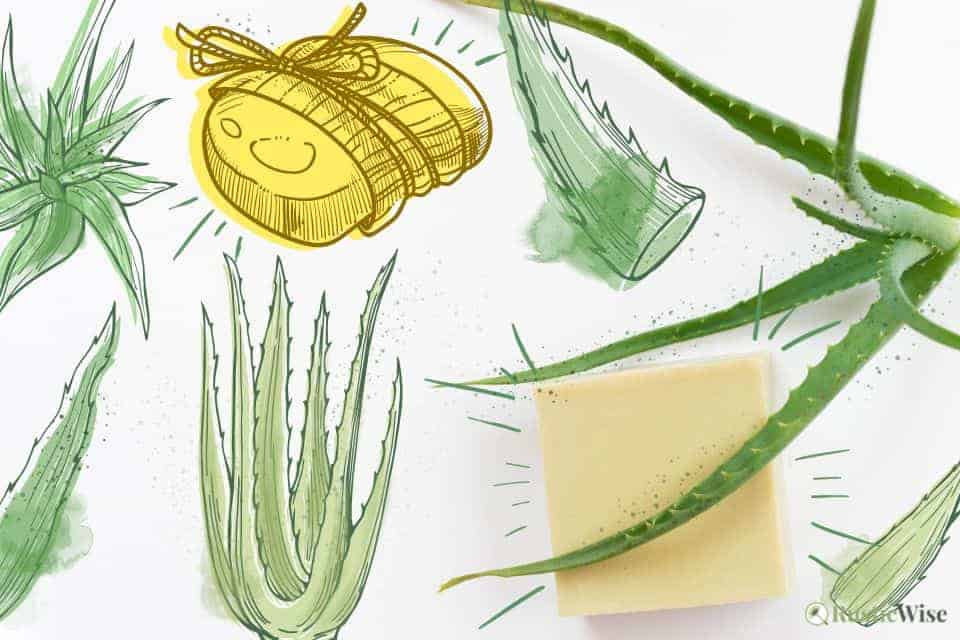
Aloe vera (Aloe barbadensis) is a healing perennial plant used to treat a variety of ailments from sun burn to skin wounds. Chances are, you might have a bottle of aloe vera gel in your medicine cabinet.
The clear gel extracted from within the leaf can be used for a wide range of medicinal and skin care purposes.
A great way to incorporate this healing gel is to use it in soap. There are many aloe vera soap benefits: it’s anti-inflammatory, moisturizing, healing, and offers skin protection. Plus, it has anti-aging properties, and may help with acne.
Let’s take a closer look at this medicinal plant and the many benefits of aloe vera soap.
A closer look at the aloe vera plant
An ancient medicinal plant, the use of aloe leaves, dates back to 1500 B.C. in many countries, including China, Greece, and Mexico. It’s believed that Egyptian queens Cleopatra and Nefertiti incorporated aloe vera in their beauty rituals.¹
A member of the Liliaceae family (of which cactus also belongs), the aloe plant grows natively in Madagascar, Iran, and Saudi Arabia.
The characteristic fleshy leaves contain a clear liquid (with a gel-like texture) that contains a host of valuable compounds. So far, at least 75 compounds have been identified in aloe, including:¹
- 20 nutrients and minerals (such as calcium, magnesium, zinc)
- 20 amino acids and essential fatty acids
- Vitamins (such as vitamin A, B12, C and E)
- Sugars (such as mucopolysaccharides which help keep moisture in skin)
- Rejuvenating enzymes
- Water
7 Aloe vera soap benefits
The many healing properties of this succulent plant make it a popular ingredient in skincare products and soap.
Fresh aloe gel freshly harvested, or store-bought gels can be added to handcrafted soap bars or liquid soaps.
Let’s take a closer look at the top aloe vera soap benefits.
Tip: The quality of aloe vera products varies widely. If you have sensitive skin, it’s best to read the ingredients label carefully and avoid soaps with artificial fragrances or synthetic coloring, which may irritate skin.
1. Soothing and gentle
If you’ve ever applied aloe vera gel to a sunburn, you’ll remember the soothing properties this medicinal plant offers.
The soothing and gentle nature of the clear gel extract contains anti-inflammatory compounds.
Skin inflammation can occur for a variety of reasons—sunburn, an allergic reaction, or more chronic skin conditions such as eczema or psoriasis.
Aloe gel contains magnesium lactate which works to prevent the production of histamine, a hormone which causes itchiness and irritation in skin.
According to the Mayo Clinic, an aloe extract cream or product may help treat mild to moderate psoriasis symptoms such as:²
- Itching
- Redness
- Scaling
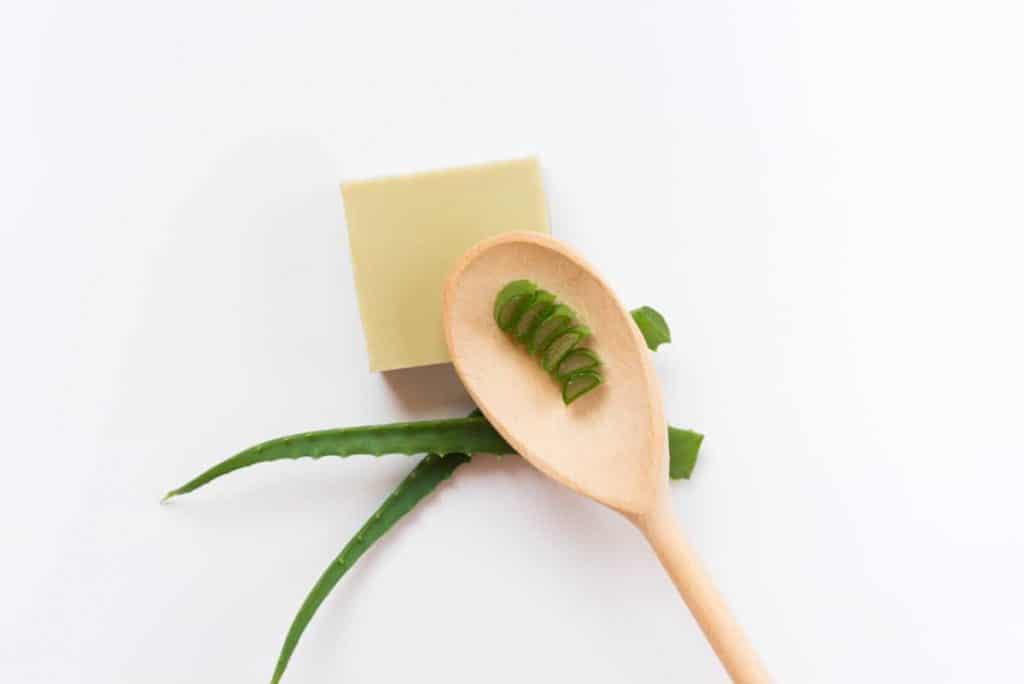
2. Moisturizing
Aloe contains a fair amount of sugars. Sugars (or sorbitol) in soap help to create lather, improve texture and also act as a humectant which draws moisture to skin.
In the case of the aloe plant, it contains a type of sugar compound called mucopolysaccharides. This acts to draw and retain moisture to the epidermis and prevents dry, flaky skin.
A great aloe vera soap benefit is improved skin softness and reduced flakiness.
One study involved delivering aloe vera gel-lined gloves to factory assembly-line workers who either had dry skin and/or contact dermatitis. Participants who wore aloe-lined gloves had better skin integrity, less wrinkling of skin, and lower levels of erythema (skin rashes).³
3. Healing qualities
Skin wounds, burns, and other viral infections can benefit from the natural treatment of a bit of aloe. Aloe is often an effective medical treatment when used either alone or combined with other medicines for a wide range of skin wounds.
Reports show that aloe vera can speed up wound healing from first- and second-degree burns. Skin lesions from the Herpes simplex virus showed quicker healing times after treated with aloe gel. And, inflammatory conditions such as Oral lichen planus (which causes patches or redness inside the mouth) showed improvement after topical aloe treatment.²
Studies also show that aloe vera gel inhibits thromboxane (which inhibits healing of wounds). This leads to speedier recovery time and less skin inflammation.¹
Other studies point to aloe’s remarkable ability to boost collagen production in wounds and improve cross-linking between collagen compounds to promote better wound healing.¹
4. Skin protection
The power of aloe extends to not only treating wounds but also appears to offer a layer of protection for skin.
Aloe vera gel offers skin protection from UV rays and other forms of radiation. Aloe may play a role in, “…altering the function of immune cells in the skin and causing the release of immunoregulatory cytokines.”⁴
Some studies show that, “…Aloe contains multiple immunoprotective factors and that Aloe oligosaccharides may prevent ultraviolet induced suppression of DTH [delayed type hypersensitivity] by reducing keratinocyte derived immunosuppressive cytokines.”⁴
Other studies show that aloe may play a preventative role in protecting skin from developing ulcers. Aloe contains mucopolysaccharides (a type of sugar molecule), amino acids, and zinc, which combat the development of skin ulcers.¹
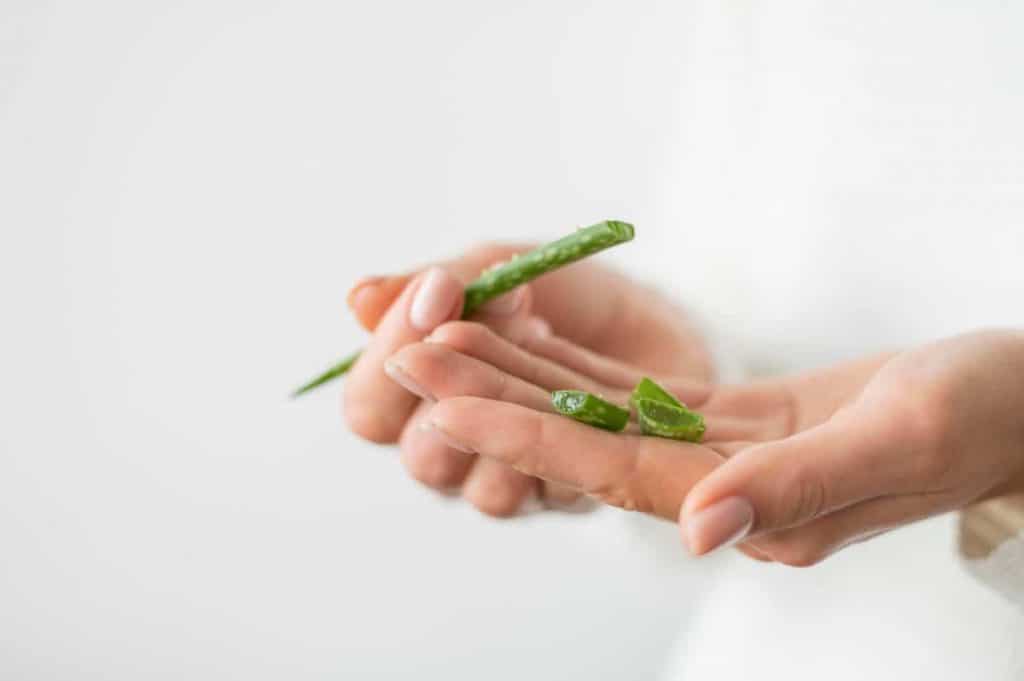
5. Promotes more youthful skin
Aloe contains many compounds which promote a more youthful complexion.
Packed with antioxidants, aloe extract can be a powerful and effective anti-aging tool. Antioxidants help fight off free radicals, which cause oxidative stress on skin cells and leads to signs of aging.
Aloe extract contains rejuvenating properties which boost collagen production. This special compound is called glucomannan, which acts to stimulate fibroblast in skin, which in turn increases collagen production in skin. The result? Fewer wrinkles.¹
The moisturizing properties of aloe gel help to moisturize skin from the inside out while also preventing superficial flaking of the skin.
Amino acids work to soften any hard skin cells, while zinc has astringent properties to reduce pore size.⁵ The result is more supple and soft skin, and a more even skin tone.
6. Antiseptic properties
Long used as a healing agent, it comes as no surprise that aloe vera has antiseptic properties. It contains six antiseptic compounds:⁵
- Lupeol
- Salicylic acid
- Urea nitrogen
- Cinnamonic acid
- Phenols
- Sulfur
Together, these six agents have antiviral and antimicrobial properties.
7. May help with acne
One of the most appealing aspects of using a natural aloe vera soap is its effectiveness in treating skin conditions like acne.
A 2014 double-blind study looked at the effectiveness of treating mild to moderate acne vulgaris with aloe together with tretinoin.⁶
Researchers found that when applied twice a day, aloe may work to reduce acne when used in combination with another acne treatment (containing tretinoin). Using aloe together with a prescribed acne treatment was more effective than the prescription medicine alone.⁶
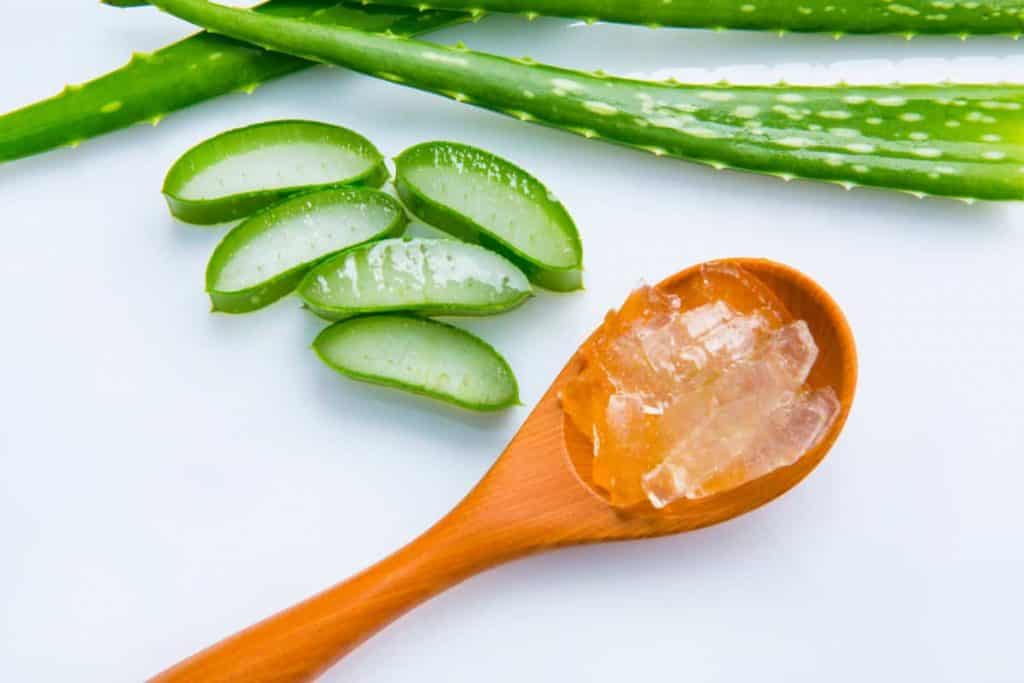
Credit: Vector State
Ways to incorporate aloe vera into homemade soap
There are many ways to add aloe to handcrafted soap bars or liquid soap.
First, let’s look at the types of aloe vera available.
Forms of aloe vera
- Fresh aloe: Can’t beat the fresh stuff! If you’re lucky enough to have an aloe vera plant at home, you can extract the gel and add it to a soap recipe. While nothing beats garden-fresh aloe, not everyone has access to the aloe plant. (And if you’re using fresh aloe in a liquid soap, it has a shorter shelf life.)
- Commercial aloe gel: Store-bought gel works fine too. Try to find one that’s free of artificial dyes and fragrances. Quality aloe gel should be clear, not dyed green. Look for a product with minimal ingredients.
- Aloe vera butter: This name is a bit deceiving. You might mistakenly buy this product thinking it’s pure aloe vera. It’s actually aloe extract combined with coconut oil. I’ve never used this yet, but am putting it on my wish list! You could use this as a base soap making oil.
- Aloe powder: You can buy dried ground aloe powder. The color ranges from yellow to green, depending on the type. It also comes in different concentrations. For example, a 200x concentration means 1 gram of powdered extract is equal to 200 grams of aloe gel. This might take a bit of experimenting with to get the right proportions!
Ways to make aloe vera soap
If making your own aloe vera soap is on your to-do list, there are a few ways to go about it.
You could leave your soap unscented, or try some of these essential oils that pair nicely with aloe vera soap:
- Lavender essential oil
- Lime essential oil
- Lemon essential oil
- Tea tree essential oil
Cold process soap
Clear liquid extracted from the aloe vera plant can be added to cold process soap recipes as a water replacement (full or partial). Aloe lends moisturizing and bubbly properties to soap.
Whether any of the beneficial properties of aloe make it through to the finished soap (after the harsh effects of lye) is up for debate (there aren’t any solid scientific studies to prove this either way). However, handmade cold process soap made with aloe seems to be bubbly and moisturizing.
You can add aloe into blended base oils. Then add lye solution to the oils. OR, you can add aloe to the combined soap batter once it has reached trace and continue to blend until it’s well incorporated.
Melt and pour soap
An easy way to make bar soap is to buy an aloe vera melt and pour soap base. It already comes with the aloe incorporated—just melt, add any additives, and pour!
If you don’t want to deal with lye, or are new to soap making, the melt and pour method is a simple way to get started.
DIY liquid aloe soap
Another quick and easy way to make the most of aloe’s healing and moisturizing properties is to make a liquid aloe vera soap using Castile soap as a base.
We’ll show you how to do this next!
Easy DIY aloe vera liquid Castile soap recipe
This plant-based recipe is a cinch to whip up. You can choose to use either fresh aloe from a plant, or store-bought aloe gel.
If you choose to go the fresh route, note that the shelf life of your soap will be shorter. As freshly squeezed aloe (nor this recipe) contains any preservatives, your soap may last about 1 week (maybe 2 weeks tops, if kept in the fridge).
If you go with shelf-stable commercial aloe vera gel, your soap will last about 2—3 months.
So, in the spirit of not wasting precious ingredients, make a smaller batch if you don’t think you’ll use it all in time!
This recipe uses a concentrated Castile soap as its base.
Note: Sometimes the ingredients in this liquid soap may separate. Simply give it a quick swirl before using, and wash away!
Supplies you’ll need:
- Measuring cups
- Soap dispenser
- Small spoon or whisk
- Bowl or container for mixing
- Funnel
Ingredients:
- 1/4 cup liquid Castile soap
- 4 cups distilled (or boiled) water
- 2 tablespoons aloe vera gel
- 10 to 20 drops essential oils (optional)—lavender, lime, lemon, or tea tree oil are good options
Note: It’s important to use distilled water, as it’s free of any minerals or chemicals that may interfere with the sudsing properties of the Castile. If you don’t have distilled water, boil water and let it cool completely before using.
- Measure aloe vera gel and water. Combine about 1 cup of water in a bowl and whisk until the two ingredients are well incorporated. Add the rest of the water and mix well.
- Add Castile soap and stir.
- Add any essential oils and stir.
- Use a funnel to pour the soap into your soap dispenser. Replace the top and give it a good swirl before using.
Enjoy! You can use this liquid soap as a hand soap or face wash (just don’t get any into your eyes!).
New to making soap? 🧼❓
👉We have a fantastic overview on the whole soapmaking process here: read our Timeless Guide To Soapmaking.
If you would like to see our soapmaking posts organized by topic type, see our Soapmaking Collection.
Would you like more timeless tips via email?
Fun tips to help you live an independent, self-sustaining lifestyle. Opt-out at any time.



Author: Theresa Tesolin
Theresa is co-founder of RusticWise. She helps people unleash their inner DIY spirit by encouraging them to get dirty and make or grow something from scratch.



